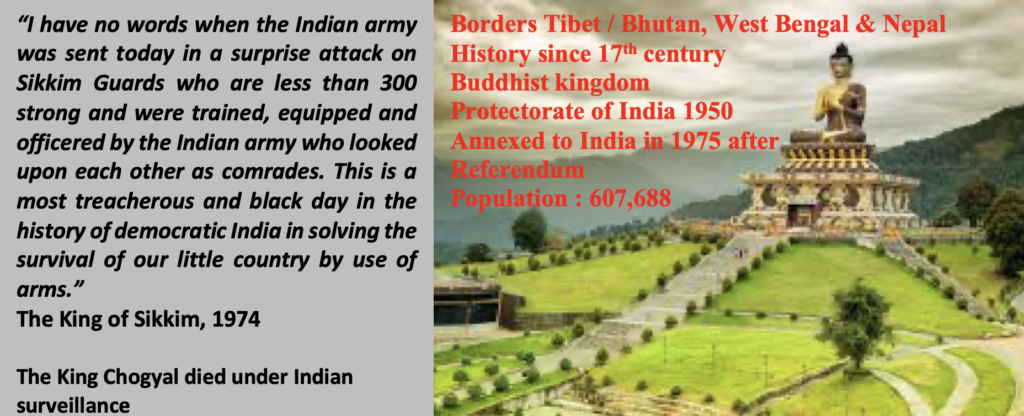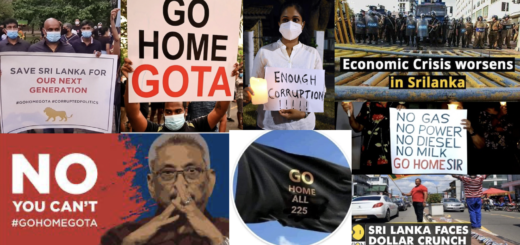India’s annexation of Sikkim & Lessons for Sri Lanka

Recently, Dr. Wasantha Bandara declared that Sri Lanka was fast on its way to becoming the 29th State of India on the lines of what happened to Sikkim. Obviously, many may be unaware of what happened to Sikkim & how it was annexed to be worried as to how Sri Lanka can be compared to it. However, the resemblances are certainly alarming. Sri Lanka’s leaders who are already not in the pocket of the bully-neighbor must take serious note.
The Himalayan kingdom of Sikkim became a protectorate of India in 1950 (“India – Sikkim Peace Treaty”) & was then constitutionally absorbed as the 22nd State of India on 15 May 1975 using espionage by Indian secret service agents. The plan to annex Sikkim to India was planned & kept secret. Therefore, Sri Lanka should always tread with caution as Sri Lanka is also under the Indian radar in particular was a “Himalayan” declaration suddenly coming to light!
Sikkim’s history dates back to the 17th century & ruled by a Buddhist-priest King Chogyal – Thondup Namgyal
Sikkim like Sri Lanka was not under British India but governed separately. Like Sri Lanka, Sikkim was of strategic importance to Colonial Britain. Sri Lanka was a monarchy until 1815, Sikkim was a monarch until 1967.
King Chogyal wanted to declare Sikkim an independent country like Bhutan & nullify the 1960 Treaty with India which made Sikkim a procreate of India.
The pro-Indian sentiments in Sikkim mirrored those shared in parts of Sri Lanka’s North & East & commercial capital Colombo and was used to peddle Indian interference.
The task of making Sikkim a state of India was given to India’s intelligence agency then headed by R N Kao. It took just over 2 years (Dec1972-May1975) to create the “democracy” demands against Sikkim monarchy & result in annexation of Sikkim to India. Ironically, Indian PM Indira Gandhi was instrumental in the outcome of Sikkim. Kao together with P N Banerjee who was a key player in the Bangladesh covert operation meticulously planned out Sikkim’s fate.
“demand for Democracy” by the people was nothing but Indian foreign intel hiring political parties, politicians, youth & individuals to join in a mass protest against the monarchy. It is said that the Sikkim National Congress was also funded by India.
The template of all externally funded agendas is to build momentum against the ruling party by funded political parties, politicians, people who are in the public and others who can be tapped & raise it to a level where the public backs them aligned to the outcome that the funding party desires. In Sri Lanka, we have seen this on several occasions. The proof that it is a funded campaign (after creating the background scenario for the protest), can be seen when the individuals or groups who came out in protest giving numerous reasons are not to be seen when a similar situation naturally arises. This is how one can differentiate between a naturally emerged protest & a funded one. A funded one will have all the main players suddenly disappear & they are gagged on referring to their role.
Every mass protest it is noteworthy is linked to the involvement of foreign intel & Sri Lanka’s was no different. Code names were created & given to agitation leaders. The “agitators” were tasked to bring the “agitation” to a point that the King would “beg” India for help. Part of the “agitation” was to chant that the King was finished & to step down. Do these chants echo “agitation” chants in Sri Lanka! We have to wonder if the “agitation” in 1983 that brought LTTE out into the open & the “agitations” in 1980s that led to Indian Peace Keepers in Sri Lanka mirrored what was designed in Sikkim! All of these “agitators” were paid handsomely for their role. Eventually, Sikkim agitations led to clashes, arson & resulted in police firing & deaths. The Indian plan was going to perfection & a draft was prepared by India for the Sikkim King to sign, no different to the 1987 Indo-Lanka Accord.
As per the India drafted “solution” administration of Sikkim was to fall under Indian government & Sikkim Commissioner of Police would be under the Indian Army. No sooner all was agreed, miraculously the agitation stopped. Don’t these scenarios look coincidental with Sri Lanka’s recent “aragala” protests. India appointed an Indian Foreign service official as Chief Executive of Sikkim. Indian PM Indira Gandhi’s orders were to have Sikkim under complete Indian control. Part of the Indian intelligence plan was to ensure that at least 70% of candidates in Sikkim’s parliament was under Indian control. One wonders how many are under Indian control in Sri Lanka’s Parliament. The “control” was to ensure legislative Bills and enactments were India-friendly. Now we know whenever any hands go up in Parliament – the reason why! With elections forthcoming in Sri Lanka, can we expect similar agitations!
India’s favored candidate won elections in 1974 with a landslide victory – as was expected. As expected he prepared a new act (Government of Sikkim Act) & it was passed also as expected. Indian-controlled Sikkim assembly members were happy to pass any resolution so long as they could enjoy power – sounds too familiar! The Indian intel wanted no bloodshed & also wanted to remove any security/soldiers loyal to the King. Thus, it was decided to disarm the Sikkim guards in 1975 after another funded agitation to disarm them. What “funds” can do! The Indians had even planned asylum for the King. Coincidentally Brig (later Lt. Gen) Depinder Singh was deployed both in Sikkim & Sri Lanka. While the Indian Army disarmed Sikkim guards, the IPKF that landed in Sri Lanka not only did not disarm the LTTE but ended up trying to create a new army to function under Indian stooge Perumal who was made the Chief Minister of merged North-East Province.
Sikkim before & after Indian occupation
Sikkim joined Kashmir, Bhutan & Nepal to remain sovereign from India when British granted independence to India in 1947. However, Sikkim had to agree to pay taxes to India, while India was to manage its foreign policy, communications & protect its borders. These “assimilations” became part of an official Treaty in 1950 & eventually led to Sikkim becoming the 22nd State of India. Similar “assimilations” taking place in Sri Lanka should connect to foreseeing the final outcome. The number of pacts being signed with India in secret by Sri Lanka’s leaders should definitely be cause for concern. No politician can be allowed to barter Sri Lanka’s sovereignty for their political survival.
Sri Lanka must take note of how India usurped Sikkim’s political movement to undermine Sikkim’s sovereignty. Indian intel organized-protests even led to the resignation of Sikkim PM.
This led to Sikkim being forced to sign a new agreement with India in 1973 – no different to Sri Lanka being forced to sign the Indo-Lanka Pact in 1987. The Agreement with Sikkim meant that India would be in charge of peace in Sikkim, Sikkim bureaucracy would be overseen by an Indian official, any conflicts will be resolved by Indian Central Government. Do any of these “agreements” resemble what is unfolding for Sri Lanka? India is copying West’s delivering democracy to its neighbors including Sri Lanka! India even introduced a law into Sikkim’s parliament which mandated an Indian representative. It is said that the Bill was passed using coercion and bribery & MPs against were jailed. India even decided the type of foreign journalists that would cover news in Sikkim. When public protested, the Indian installed police took action. This was how a pro-Indian PM came to power in 1974 in Sikkim. What should also be a concern in Sri Lanka is the manner India began to cripple Sikkim’s national movements & most infiltrated with pro-Indian “nationalists”.
It was a year later in 1975 that the Indian army marched into Sikkim, attacked the kings army & disarmed them, took over Sikkim borders, & made the Sikkim king prisoner & held a referendum. Not surprisingly, this referendum was rigged & monarchy was dissolved with Sikkim assimilated to India. Sri Lanka be cautious of sham referendums which resulted in Sikkim’s annexation to India in 1975. Foreign journalists did not cover the referendum & the Indian journalists who criticized it, lost their jobs. Maldives aware of the dots of Indian aid/investments/institutions/internal interferences, was wise enough to elect a leader whose election campaign was “quit India”.
When India abrogated the special status accorded under section 370 of the Indian constitution to Jammu Kashmir in 2019, pro-Buddhist Sikkim which also enjoys special status under 371F, feared it may lose the special protection given. Noteworthy, is the pains India takes over “ownership” of Buddhism. Sikkim values its “spiritual democracy’ which was headed by a Buddhist king. However, traditional Sikkims are concerned that since 1975 annexation with India 99% of those in power are non-Buddhists. This is a concern for Sinhala Buddhists in Sri Lanka in the manner Buddhist archaeological sites are being systematically attacked across the island in particular North & East & being replaced with Hindu idols. These incidents can be manipulated at any time to create the necessary tensions to tweak into an external plan. The understanding of the context behind the motives is what Sri Lanka’s leaders & policy advisors need to be aware of. In Sikkim, christian evangelism is targeting poorer Buddhists. Sikkims entire demography has changed. The place of Buddhism is at stake in less than 50 years! Out of Sikkim’s 32 seats in Parliament, 12 are reserved for 2 indigenous groups who are Buddhists. There is a “Sangha seat” reserved for a registered Buddhist thero. All this will end if India abrogates the section 371F. The concern is no different to the manner Article 9 and other Buddhist elements are being systematically attacked & targeted in Sri Lanka.
Sikkim has its heritage but how its heritage is to be practiced or maintained is decided by India. These are the factors that Sri Lanka must be concerned about too.
Shenali D Waduge







